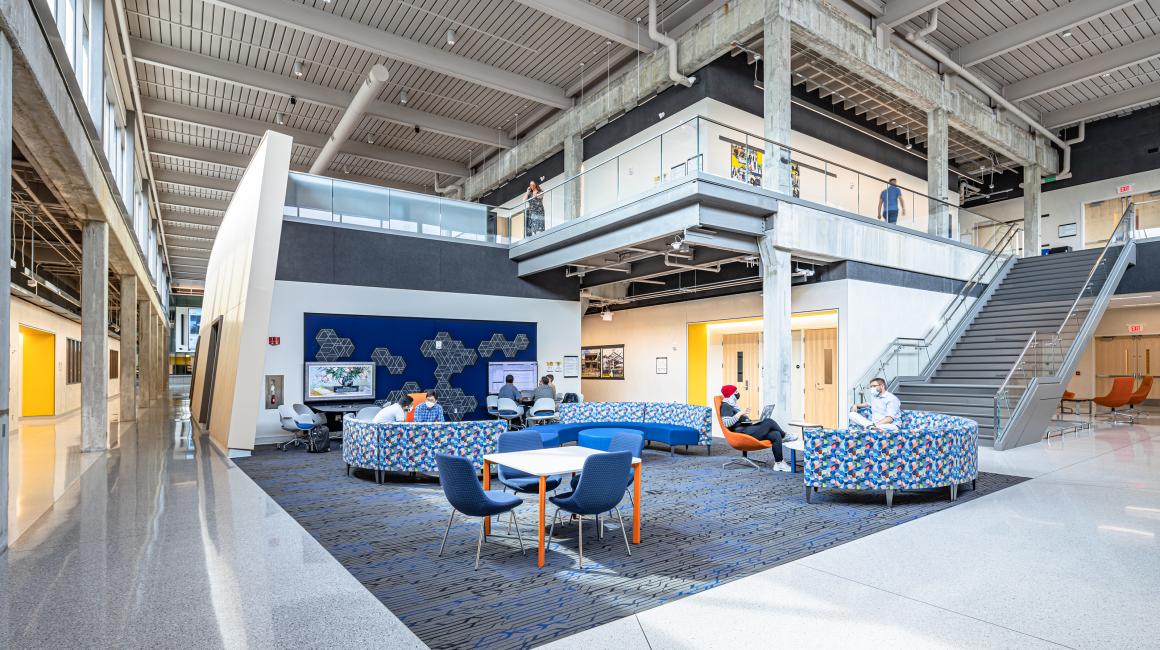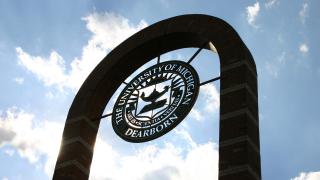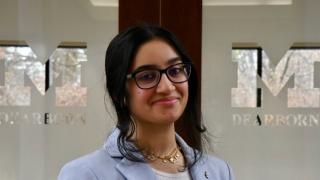
One of the welcomed new qualities of the conversation around UM-Dearborn’s strategic plan is that we no longer have to talk about it in the future tense. Core parts of the plan were finalized and released back in April, and though it may have flown somewhat under the radar due to the pandemic, implementation of many of the plan's core initiatives is now well underway. At a recent virtual strategic planning update, university leaders shared details on the progress of some current and future initiatives. We’ve summarized some of the takeaways from the event below in case you missed it. Or you can watch the full 90-minute update on the university YouTube channel.
Who is UM-Dearborn in 2021?
One of the outcomes you hope for in any strategic planning process is to give folks a clearer sense of an institution's contemporary identity and purpose. During the course of the strategic planning process, dozens of faculty, staff and students contributed to rich conversations around that topic, coalescing in an exciting new way to think about UM-Dearborn. Chancellor Grasso summarized it by sharing a short narrative statement that was unanimously approved by 18 members of senior leadership.
University of Michigan-Dearborn is a diverse and welcoming 21st-century commuter-based campus that opens the door to an accessible American dream for students of all socioeconomic levels, and is above all committed to the success of each individual student. Harkening back to the roots of our founding, we are a practice-based university that focuses on positively impacting Southeastern Michigan and beyond by creating and applying knowledge to address our most compelling problems. We do this by: connecting students with extramural opportunities to enhance their classroom studies and create opportunities for professional careers; supporting faculty with community and corporate engagement opportunities; and holistically driving economic vibrancy. Our faculty and programs differ from those of our progenitor in substance but not in quality. Our practice-based programs are of equal quality to programs in Ann Arbor. Finally but not least, UM-Dearborn is a unique, caring, close-knit community where we place the mission first but always take care of all of our people.
Student experience and success
UM-Dearborn’s strategic plan is animated by four guiding principles: student experience and success; diversity, equity and inclusion; faculty and staff excellence; and economic sustainability. In the area of student experience and success, there have already been some important developments, one of the most exciting being a reorientation of the student aid strategy toward students with the greatest financial needs. For sure, the most headline grabbing part of that effort is an extension of the Go Blue Guarantee to the Dearborn campus, which provides free tuition to high achieving new and transfer students whose annual family incomes are under $65,000. But Vice Provost for Enrollment Management Melissa Stone says UM-Dearborn has also greatly expanded its aid for students who don’t meet the GPA or income requirements of the Go Blue Guarantee. In short, because need is a sliding scale, we’ve adjusted our aid to make sure anyone can afford an education at UM-Dearborn. If you want to see how that works, check out this really great breakdown of how UM-Dearborn’s new aid strategies are serving students with the most financial need.
Other things to watch in the student experience and success area:
- The university launched a new online student service portal that connects students to advisors, financial aid, and other key university services from a single page. Enrollment Services is also staffing a new “One Stop” in the University Center for students who want in-person help.
- The university has been expanding its use of Salesforce, our customer relationship management (CRM) software. This helps fine-tune student communications so they’re extra relevant and has a growing set of applications for both recruitment and retention.
- Experience+ was launched in January 2021 to coordinate and enhance opportunities for student professional development, research, intercultural awareness and digital literacy.
- A new peer-to-peer mentoring service has been heavily used by students. In its first semester, 137 upper-level students are mentoring 500 first- and second-year students, exchanging more than 9,000 messages.
- Some areas of the University Center are getting a makeover to provide the spaces and services commuter students need most. Renovations include a new lounge area on the second floor for hanging out and studying between classes, as well as easier ways for students to access student life opportunities, like student organizations.
Diversity, equity and inclusion
Work centered on advancing diversity, equity and inclusion (DEI) touches nearly every aspect of university life. The DEI strategic planning working group produced over 60 recommendations in all, some of which are already being implemented. Initial steps include some notable changes to human resources practices and policy. The university is now requiring an unconscious bias mitigation training for anyone participating on search committees, and is being more intentional about the language used in job descriptions to attract a wider diversity of applicants. Other changes include offer letters that set expectations for promoting diversity, equity and inclusion and new Human Resources “equity reviews” of position compensation and job classifications.
Other initiatives in the works: An expansion of the MLK Day of Service and Learning, featuring an enhanced partnership with neighboring Henry Ford College; the creation of a new Chancellor’s DEI Fellowship; and the continued implementation of flexible and remote work opportunities that help promote diversity, equity and inclusion goals.
Faculty and staff excellence
Teams working on faculty-related issues haven’t wasted time diving into meaningful territory. One of the first initiatives focuses on broadening the criteria by which faculty are evaluated for tenure and promotions. In particular, this would include new ways of valuing community-based work, pedagogical research, and exceptional teaching or support for students, in addition to faculty contributions to their respective scholarly communities. Another big theme: promoting interdisciplinary research. On that front, campus has launched a new thematic research grant program, which provides funding for projects featuring researchers from at least two colleges. (The initial themes are sustainability, mobility and infrastructure, and diversity, equity and inclusion.) In addition, faculty have launched three interdisciplinary research groups so far, giving researchers from different disciplines a new platform for sharing ideas and partnering on bigger grants. Over the past year, the Office of Research has also expanded its support, including retaining a firm that specializes in helping faculty write and copyedit federal grants. Next up, the office hopes to build out its post-award support, which faculty have identified as a key need.
On the staff front, highlights include new professional development opportunities and leadership training.
Economic sustainability
When it comes to the university’s finances, one of the biggest changes is a new model called zero-based budgeting. As we’ve explained in past town hall recaps, this involves building a base budget for each campus unit based on exactly what it needs to accomplish its present mission, rather than, say, what its budget has been historically. This model, which emphasizes a balance between revenues and expenses at the unit level, provides an impetus for entrepreneurial projects. For example, if a college created revenue-generating research, it could also keep and invest that money within the college.
As you know, UM-Dearborn’s budget is powered mostly by tuition revenues, and it’s been a challenging time for universities across the country when it comes to enrollment. Pandemic-related issues and a significant decline in transfer students have been the main sources of recent enrollment declines at UM-Dearborn. The uncertainty of the pandemic has also made it difficult to pursue strategic enrollment management plans, but Vice Provost for Enrollment Management Melissa Stone says that work is now moving back to the front burner. Because enrollment declines in a particular year have multi-year impacts, Stone says the goal is to get back to 2017-2018 enrollment levels within a few years. The strategy will be centered around recruitment of multiple student populations, including international graduate students and students who’ve started but not finished a degree. The other key part of enrollment growth: boosting retention. Stone says the teams working on these issues will spend the next few months developing enrollment strategies, with a goal of having a fully developed Strategic Enrollment Management Plan ready to go by May 2022.
Another key piece of our economic sustainability is environmental sustainability. To reach the U-M system’s goal for carbon neutrality, meaningful investments will have to be made in energy efficiency and weaning our university off fossil fuels in the coming decades. To achieve those objectives, the university has so far created a campus Energy and Sustainability Team, developed a campuswide energy efficiency plan, and completed a lighting audit of most major buildings. Future plans include bringing Ann Arbor’s Planet Blue Ambassador program to the Dearborn campus, building an energy and sustainability website to track progress, and developing sustainability-focused teaching modules for faculty.
Finally, UM-Dearborn is now preparing for another major capital campaign, so stay tuned for details on that in the coming year.
###
Still want to learn more about UM-Dearborn’s strategic plan? Check out the full 90-minute video of the Nov. 18 update or visit the strategic planning website.




